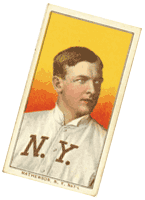Legends of the Dead-Ball Era, 1909-1913
The Paragon & the Peach
The Paragon & the Peach
-
Ty Cobb & Christy Mathewson

Christy Mathewson Stepping off the campus of Bucknell University and out of the pages of Tip-Top Weekly, Christy Mathewson became the darling of the professional baseball world in the early 1900s.
Handsome, intelligent, hard-working and clean-living, the godlike Matty embodied the most virtuous qualities of the Protestant ethic in sport, almost single-handedly helping baseball clean up its previous image as a game for ruffians and rubes.
Possessed of tremendous poise and a killer out-pitch—his famous "fadeaway" (a screwball)—Mathewson led John McGraw's New York Giants to unprecedented heights of success between 1900 and 1915. His three shutouts against the Philadelphia Athletics in the 1905 World Series is a feat of nearly unimaginable scope.
His book Pitching in a Pinch (1912) and his frequent newspaper contributions made Matty one of the most popular and emulated ballplayers. Like many heroes, Mathewson died at a tragically young age, succumbing to tuberculosis in 1925. His spirit and place in American popular culture continues to live through works of popular fiction such as Eric Rolfe Greenberg's The Celebrant and the recent one-man play, Matty

Lean, vicious and driven by the need to excel regardless of the consequences, Ty Cobb was the dominant player during the second half of the dead-ball era and the first southerner to attain superstar status.
Described by a latter-day historian as a "psychopath on spikes," Cobb—The Georgia Peach—battled everyone, including his own teammates, both on and off the field of play. In fact, Cobb's tempestuous behavior was so well documented by 1911 that even grade-school children could joke about it, as witnessed in this letter to Dick Russell from his younger sister Harriette.
Cobb brought the dash and daring of the dead-ball game to its highest peak of expertise and refinement, batting over .400 three times during his 24-year career and retiring with the highest career batting average of any player (.367) in major-league history.
A betting scandal hastened his departure from the game in the late 1920s, but never hampered his ability to make money. Thanks to wise, early investments in General Motors and Coca-Cola, Cobb retired to a life of wealth and ease following the 1928 season. When he died at the age of seventy-four in 1961, only three representatives from organized baseball attended his funeral.
-
Ty Cobb's batting fundamentals:
- DON'T GRIP YOUR BAT AT THE VERY END; leave say an inch or two. ALSO, LEAVE AT LEAST AN INCH OR MORE SPACE BETWEEN YOUR HANDS; that gives you balance and control of bat, and also keeps hands from interfering with each other during swing.
- Take position at plate, especially against right hand pitchers, BACK OF PLATE, and against a man with a real curve, YOU CAN STAY ON BACK LINE OF BATTING BOX. Now try to hit to right-center. I don't mean you should place the ball in any one spot, but start now practicing to hit your righthanders to the opposite field. An inside ball from a right-hand pitcher you will naturally pull, say, to left-center.
- DON'T SLUG AT FULL SPEED; LEARN TO MEET THEM FIRMLY, and you will be surprised at the results.
- Now, to hit as I ask, to right-center or center. YOU STAND AWAY FROM PLATE the distance you can see with mind's eye that you can hit the ball that curves on inside corner, to center. This distance away from the plate will allow you to hit the outside ball to right. In other words, you protect the plate both on inside pitches and outside.
- Remember, THE PLATE IS THE PITCHER'S OBJECTIVE AND HE HAS TO COME TO IT. I use 'back of plate' expression to mean towards the catcher, away from plate to denote distance from plate towards outside of box. Now, USE A SLIGHTLY CLOSED STANCE, AND KEEP A LITTLE MORE WEIGHT ON YOUR FRONT FOOT THAN BACK. That gives you balance and won't pull you away from curves. You are always in position to give maximum drive.
- DON'T PULL A CURVE BALL FROM A RIGHTHANDER. The ball is revolving away from you. He with the revolution and to right-field.
- KEEP YOUR LEFT ELBOW COCKED ON LEVEL WITH YOUR HANDS OR EVEN HIGHER. Never let the elbows down below the hands, and keep your hands always well away from the body - keep pushing them out, even with your body or back.
- KEEP YOUR BACK LEG STRAIGHT. Of course, if you put your weight more on the front leg, then the back leg will be straight.
- IF HIGH FAST BALLS INSIDE REALLY BOTHER YOU: crouch over from waist and pass them up. Don't bite, in other words. In crouching, you make the pitcher throw lower, which forces him away from the position that bothers you. But I think with the instructions I have given, you will hit them wherever they pitch.
- AGAINST A SPEEDY LEFT-HANDER DON'T PULL. Use same stance I have given you, and when he throws you his curve, knock him down with it or you will naturally pull it, as the ball is breaking in to you. BUT AGAINST A LEFT-HANDER OF FAIR SPEED: Move up in the box, also closer to the plate, and PULL THIS STYLE OF PITCHING.